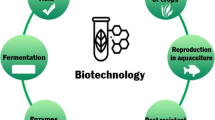Abstract
Sorghum is a major cereal crop in the USA. However, sorghum has been underutilized as a renewable feedstock for bioenergy. The goal of this research was to improve the bioconversion efficiency for biofuels and biobased products from processed sorghum. The main focus was to understand the relationship among “genetics–structure–function–conversion” and the key factors impacting ethanol production, as well as to develop an energy life cycle analysis model (ELCAM) to quantify and prioritize the saving potential from factors identified in this research. Genetic lines with extremely high and low ethanol fermentation efficiency and some specific attributes that may be manipulated to improve the bioconversion rate of sorghum were identified. In general, ethanol yield increased as starch content increased. However, no linear relationship between starch content and fermentation efficiency was found. Key factors affecting the ethanol fermentation efficiency of sorghum include protein digestibility, level of extractable proteins, protein and starch interaction, mash viscosity, amount of phenolic compounds, ratio of amylose to amylopectin, and formation of amylose-lipid complexes in the mash. A platform ELCAM with a base case showed a positive net energy value (NEV) = 25,500 Btu/gal EtOH. ELCAM cases were used to identify factors that most impact sorghum use. For example, a yield increase of 40 bu/ac resulted in NEV increasing from 7 million to 12 million Btu/ac. An 8% increase in starch provided an incremental 1.2 million Btu/ac.









Similar content being viewed by others
References
Renewable Fuels Association (RFA) (2007) Building new horizons: Ethanol industry outlook 2007. Available at: http://www.ethanolrfa.org/media/pdf/outlook_2007.pdf
Wu X, Zhao R, Bean SR, Seib PA, McLaren JS, Madl RL, Tuinstra M, Lenz MC, Wang D (2007) Factors impacting ethanol production from grain sorghum in the dry-grind process. Cereal Chem 84:130–136
Wu X, Zhao R, Wang D, Bean SR, Seib PA, Tuinstra MR, Campbell M, O’Brien A (2006) Effects of amylose, corn protein, and corn fiber contents on production of ethanol from starch rich media. Cereal Chem 83:569–575
Farrell AE, Plevin RJ, Turner BT, Jones AD, O’Hare M, Kammen DM (2006) Ethanol can contribute to energy and environmental goals. Science 311:506–508
Zhan X, Wang D, Bean SR, Mo X, Sun XS, Boyle D (2006) Ethanol production from supercritical-fluid-extrusion cooked sorghum. Ind Crop Prod 23:304–310
Rooney LW, Pflugfelder RL (1986) Factors affecting starch digestibility with special emphasis on sorghum and corn. J Anim Sci 63:1607–1623
Zhang G, Hamaker BR (1998) Low α-amylase digestibility of cooked sorghum flours and the effect of protein. Cereal Chem 75:710–713
Streeter MN, Wagner DG, Hibberd CA, Mitchell ED Jr, Oltjen JW (1990) Effect of variety of sorghum grain on digestion and availability of dry matter and starch in vitro. Anim Feed Sci Technol 29:279–287
Duodu KG, Taylor JRN, Belton PS, Hamaker BR (2003) Factors affecting sorghum protein digestibility. J Cereal Sci 38:117–131
Hamaker BR, Kirleis AW, Butler LG, Axtell JD, Mertz ET (1987) Improving the in vitro protein digestibility of sorghum with reducing agents. Proc Natl Acad Sci USA 84:626–628
Oria MP, Hamaker BR, Axtell JD, Huang CP (2000) A highly digestible sorghum mutant cultivar exhibits a unique folded structure of endosperm protein bodies. Proc Natl Acad Sci USA 97:5065–5070
Mezo-Villanueva M, Serna-Saldivar SO (2004) Effect of protease addition on starch recovery from steeped sorghum and maize. Starch 56:371–378
Moheno-Perez JA, Almeida-Dominguez HD, Serna-Saldivar SO (1999) Effect of fiber degrading enzymes on wet-milling and starch properties of different types of sorghums and maize. Starch 51:16–20
Xie X, Seib PA (2002) Laboratory wet-milling of grain sorghum with abbreviated steeping to give two products. Starch 54:169–178
Yang P, Seib PA (1995) Low-input wet-milling of grain sorghum for readily accessible starch and animal feed. Cereal Chem 72:498–503
Yang P, Seib PA (1996) Wet-milling of grain sorghum using a short steeping period. Cereal Chem 73:751–755
Beta T, Corke H (2001) Genetic and environmental variation in sorghum starch properties. J Cereal Sci 34:261–268
Beta T, Corke H, Rooney LW, Talor JRN (2001) Starch properties as affected by sorghum grain chemistry. J Sci Food Agric 81:245–251
Huber KC, BeMiller JN (2000) Channels of maize and sorghum starch granules. Carbohydr Polym 41:269–276
Lee L, Ng PKW, Whallon JH, Steffe JF (2001) Relationship between rheological properties and microstructural characteristics of nondeveloped, partially developed, and developed doughs. Cereal Chem 78:447–452
American Association of Cereal Chemists (2000) Approved methods of the AACC, methods 46–30: crude protein—combustion method, 10th edn, AACC, St. Paul
American Association of Cereal Chemists (2000) Approved methods of the AACC, methods 76–13: total starch assay procedure (Megazyme Amyloglucosidase/alpha-Amylase Method), 10th edn. AACC, St. Paul
Mertz ET, Hassen MM, Cairns-Whittern C, Kirleis AW, Tu L, Axtell JD (1984) Pepsin digestibility of proteins in sorghum and other major cereals. Proc Natl Acad Sci USA 81:1–2
Boltz KW, Thompson DB (1999) Initial heating temperature and native lipid affects ordering of amylose during cooling of high-amylose starches. Cereal Chem 76:204–212
Naidu K, Singh V, Johnston DB, Rausch KD, Tumbleson ME (2007) Effects of ground corn particle size on ethanol yield and thin Stillage soluble solids. Cereal Chem 84:6–9
Acknowledgments
This project was supported by the National Research Initiative of the USDA Cooperative State Research, Education, and Extension Service, grant number 2004-35504-14808. The authors would like to thank Novozymes Inc. for providing Liquozyme SC DS and Spirizyme Fuel, and Fermentis of S.I. Lesaffre for the active dry yeast, Ethanol Red, used in this research.
Author information
Authors and Affiliations
Corresponding author
Additional information
JIMB-2008: BioEnergy-Special issue.
Rights and permissions
About this article
Cite this article
Wang, D., Bean, S., McLaren, J. et al. Grain sorghum is a viable feedstock for ethanol production. J Ind Microbiol Biotechnol 35, 313–320 (2008). https://doi.org/10.1007/s10295-008-0313-1
Received:
Accepted:
Published:
Issue Date:
DOI: https://doi.org/10.1007/s10295-008-0313-1




